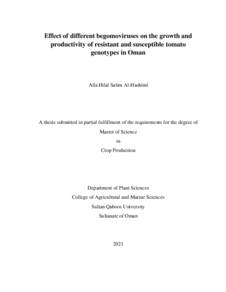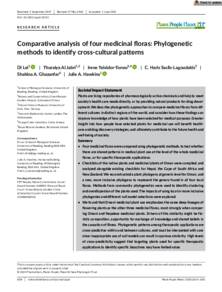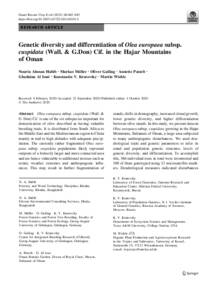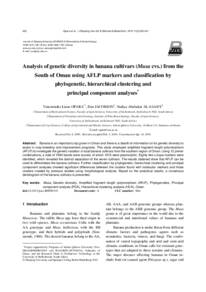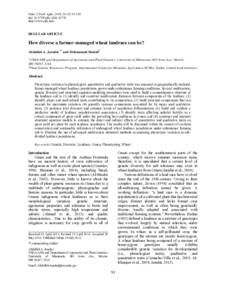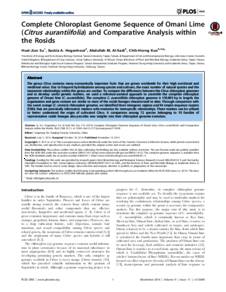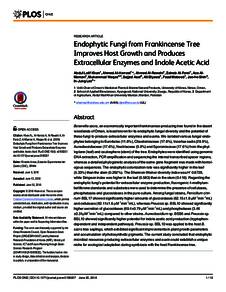وثيقة
Effect of different begomoviruses on the growth and productivity of resistant and susceptible tomato genotypes in Oman.
الناشر
Sultan Qaboos University.
ميلادي
2021
اللغة
الأنجليزية
الملخص الإنجليزي
Tomato (Lycopersicon lycopersicum L.) is one of the major vegetable crops grown world
widely. The biotic stress caused by Tomato Yellow Curl Leaf Virus (TYLCV) is a serious
problem that can lead to 100% economic loss. TYLCV is caused by begomovirus genus of
the family giminivirdae which is a single stranded DNA. Resistance to begomoviruses is an
essential breeding aim for cultivated tomato. Numerous resistance genes have been
characterized in tomato wild species and introgressed into cultivated tomato species. Six
major resistance genes had been identified; these are Ty-1 to Ty-6.
In the present study, ten tomato genotypes harboring one or more of three TYLCD resistance
genes (Ty-1, Ty-2 and Ty-3) were tested by PCR and assessed for their resistance against
TYLCV/ChiLCV using modified assessment scale in two locations in Oman. Also, the effect
of virus infection on yield, plant height in cm and chlorophyll estimation using SPAD meter
were studied. This study was done to test the hypothesis that tomato genotypes containing Ty
genes are resistant against begomoviruses and therefore have better growth and productivity
than tomato genotypes lacking Ty genes.
The results demonstrated that GS12 which have no resistant genes was susceptible to
TYLCV/ChiLCV as it showed the highest virus infection percentage. Genotypes T2a and T3
containing Ty-1, Ty-2 and Ty-3 genes were tolerant. T10 and T6 genotypes both had low
resistance. The rest genotypes had a moderate resistance. The resistant T3 genotype showed
the highest yield weight. The resistant T2a genotype obtained the highest chlorophyll
estimation. The susceptible GS12 genotypes showed the lowest yield and there was a
noticeable reduction in the chlorophyll estimation which was expected as yellowing is one
of the major symptoms of TYLCD. The virus infection did not affect the plant height in this
experiment.
المجموعة
URL المصدر
الملخص العربي
تعتبر الطماطم من أهم محاصيل الخضر في العالم. يعد الإجهاد الحيوي الناجم عن فيروس تجعد أوراق الطماطم الصفراء (TYLCV (مشكلة خطيرة حيت من الممكن أن تؤدي إلى خسارة محصول بنسبة 100 . ٪يحدث فيروس TYLCV بسبب جنس البيجوموفيروس التي تنتمي لعائلة الجرميفيريديا و هو عبارة عن حمض نووي أحادي الجديلة لتكاثر الطماطم المزروعة. لقد تم إدخال العديد (DNA stranded-single .(تعد مقاومة البيجوموفيروسات هدفاًمهماً من جينات المقاومة و تم تمييزها وراثياً في أنواع الطماطم البرية. حيث تم تحديد ستة جينات مقاومة رئيسية، و هي من .Ty-6 إلى Ty-1 في هذه الدراسة، تم فحص و تقييم عشرة أنماط جينية للطماطم باستخدام تفاعل البلمرة المتسلسل PCR ،حيث تحتوي هذه الإنماط على واحد أو أكثر من ثلاثة جينات مقاومة لمرض التجعد الإصفر ألوراق الطماطم، لمقاومتها ضد ChiLCV/TYLCV في موقعين مختلفين في عمان. كما تم دراسة تأثير الإصابة بهذا الفيروس على محصول الطماطم و ارتفاع النبات و تقدير الكلوروفيل. أجريت هذه الدراسة الختبار الفرضية القائلة بأن التراكيب الجينية للطماطم المحتوية على جينات Ty تقاوم البيجوموفيروس وبالتالي تتمتع بنمو وإنتاجية أفضل من التراكيب الوراثية للطماطم التي تفتقر إلى جينات Ty. أظهرت النتائج أن GS12 الذي ال يحتوي على جينات مقاومة كان عرضة لإلصابة بـ ChiLCV / TYLCV حيث أظهر أعلى نسبة إصابة بالفيروس. كانت الإصناف T2a و T3 التي تحتوي على جينات 1-Ty و 3-Ty و 2-Ty مقاومة. كان لكل من الإصناف T10 و T6 مقاومة منخفضة. كانت بقية الإصناف المقاومة معتدلة. أظهر الصنف T3 المقاوم أعلى وزن محصول. حصل خط T2a المقاوم على أعلى تقدير للكلوروفيل. أظهرت خطوط GS12 الحساسة أقل إنتاجية وكان هناك انخفاض ملحوظ في تقدير الكلوروفيل والذي كان متوقعًا حيث أن الإصفرار هو أحد الإعراض الرئيسية لـ TYLCV .لم تؤثر الإصابة بالفيروس على ارتفاع النبات في هذه التجربة.
قالب العنصر
الرسائل والأطروحات الجامعية

